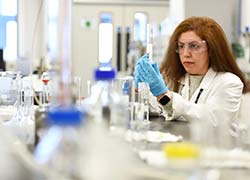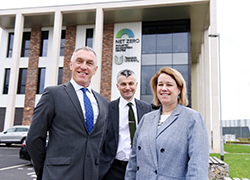Green coating for Eco flights
Environmental concerns mean the next generation of aircraft will need more powerful electrical generators to reduce weight and improve fuel efficiency. And material scientists at Teesside are playing their part by developing a wiring coating capable of withstanding very high temperatures without melting, as part of a government-backed research programme. Keith Seacroft reports.
It may be only a plastic sheath to most of us non-electrical specialists, but the covering round the wires in any cable, circuit, plug, component or appliance is the difference between success and disaster.
It’s there to keep the wires apart and the current on track. If it fails, there’s a short circuit causing fuses to blow, machines to stop and systems to break down. It’s bad enough when the fault blacks out your reading lamp but when the wiring is inside a jet engine, generating power for all the electrics in an aircraft, this thin coating becomes a life-support system for all on board. This is why careful research goes into every aircraft component.
And the 21st century is bringing about a new era of air travel where safety is joined by environmental concerns. The UK’s former Department of Trade & Industry (DTI) has funded a major technology research project with 16 companies, including Rolls-Royce plc and Goodrich Power Systems, and academic teams from several universities. The overall research programme, called Advanced Electric Machines through Materials, sets out six key challenges, all concerned with the two principal requirements for motors and generators – magnets and coils of wire. They have substantial implications for eco-friendly flying, as well as other forms of travel and manufacturing.
Wiring insulation is one of these themes and scientists and engineers at the University of Teesside are working on the solution - a new nanocomposite material, part-plastic, part-ceramic, to replace traditional coatings. Designs for future aircraft, such as the Boeing 787, will have to be more eco-friendly and carry a much greater range of electrical and electronic systems, for example, in place of the heavy hydraulics that operate flaps on the wings.
These changes will reduce weight, improve fuel efficiency and help reduce emissions. They will also result in more responsive, safer and ultimately cheaper systems. But they need a significantly bigger on-board source of power.
The best place to locate the generators is inside the jet engine, but with traditional materials and methods, the magnets and wiring used for generating power cannot withstand the high temperatures which could exceed 500°C. Existing exotic plastics will go as far as 200°C, but that’s their limit. To date this has been an insurmountable obstacle for designers and engineers.
The Teesside team, led by Professor Simon Hodgson, Dean of the University’s School of Science & Technology and head of its IDEAS Institute, is developing a coating that will work in such extreme conditions.
His team started work on the DTI project at Loughborough University but moved as a group to Middlesbrough, both to be nearer the chemical process industries and manufacturing opportunities, and to take advantage of new University research facilities. To meet the extreme demands of this application they have devised a new material, known as a ‘ceramer’, incorporating characteristics of ceramics and polymers.
‘The coating needs to be thin but strong, and stable both at high temperatures and under the high forces produced in a rapidlyrotating generator’, says Professor Hodgson. ‘It has to be very robust to survive the production process and the operating environment, whilst being thin and flexible enough to allow the wire to be tightly and compactly coiled as a component of the generator. And it must have an even thickness and no holes that would cause a 1,000-volt short circuit.’
Professor Hodgson likens the properties of the ceramer to ‘a soft pencil-lead’ that covers the core copper wire to micrometer-scale thickness – a fraction of a hair’s-breadth. It is being developed in a high-precision chemical engineering operation. This crucial step – which is Teesside’s speciality – is called a sol-gel process. It takes individual molecules of polymer and ceramic and constructs them chemically in solution, where they react together. Initially the product of the reaction is flexible like a polymer, and is suitable for coating the copper and allowing the completed wire to be coiled.
In the high temperatures inside the engine, it undergoes a chemical change, ‘a controlled decomposition’, and the hard ceramic-like qualities take over.
‘Although our work at Teesside is specifically geared to allowing power generation in aircraft at higher temperatures, it will have other uses’, says Professor Hodgson.
The overall research programme has a broader objective and will have far-reaching benefits for motor transport and other applications in industry and the home.
But above all it will be another step towards achieving the goal of flying greener.
 Supporting Nigerian farmers by transforming food waste into
...
Supporting Nigerian farmers by transforming food waste into
... International partnership signed with prestigious American
...
International partnership signed with prestigious American
... Teesside University academics join prestigious network of
...
Teesside University academics join prestigious network of
...